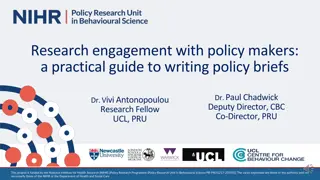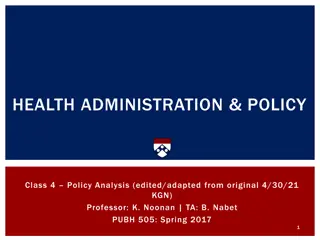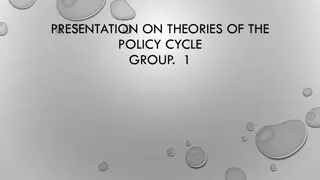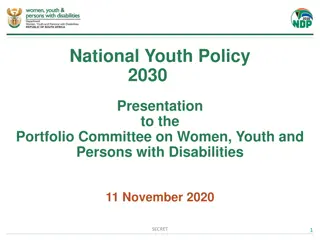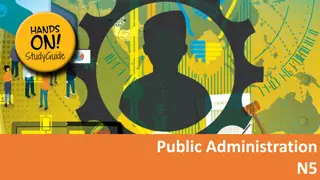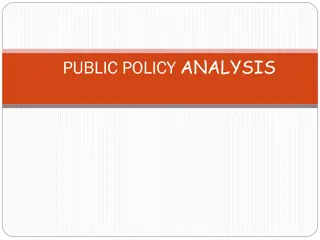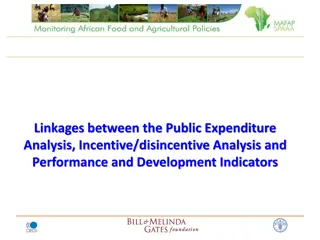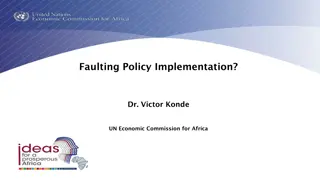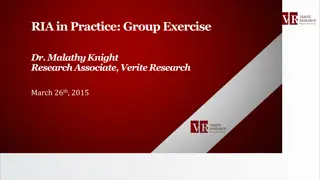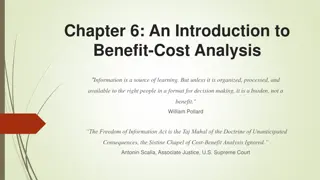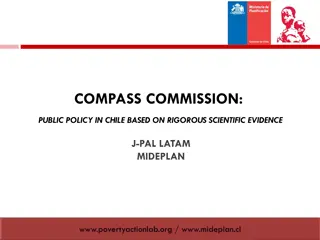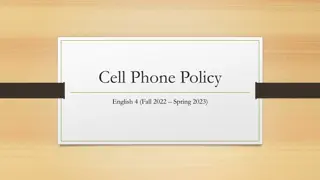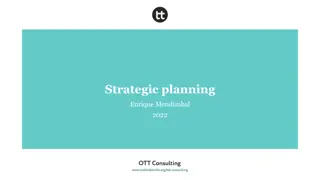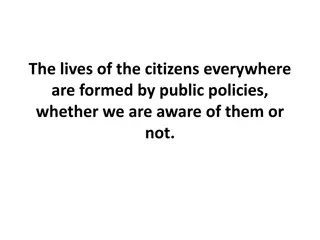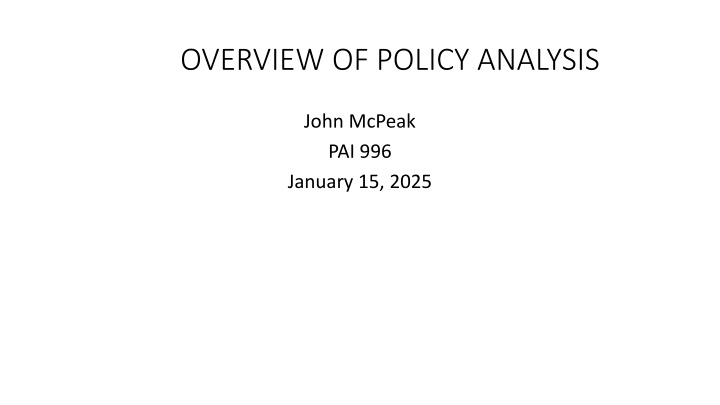
Salmon Fishery Policy Analysis Report
Conduct a policy analysis of the small boat salmon fishery along the Pacific coast for the new federal Canadian government. Assess current policies, investigate alternatives, and recommend strategies to achieve economic efficiency, fishery preservation, equitable distribution, and political feasibility.
Download Presentation

Please find below an Image/Link to download the presentation.
The content on the website is provided AS IS for your information and personal use only. It may not be sold, licensed, or shared on other websites without obtaining consent from the author. If you encounter any issues during the download, it is possible that the publisher has removed the file from their server.
You are allowed to download the files provided on this website for personal or commercial use, subject to the condition that they are used lawfully. All files are the property of their respective owners.
The content on the website is provided AS IS for your information and personal use only. It may not be sold, licensed, or shared on other websites without obtaining consent from the author.
E N D
Presentation Transcript
OVERVIEW OF POLICY ANALYSIS John McPeak PAI 996 January 15, 2025
Policy Analysis Example Chapter 16, Weimer and Vining 6thedition
The Premise A new federal Canadian government has been elected Minister of Fisheries, Oceans and the Canadian Coast Guard has asked you to conduct an analysis of the small boat salmon fishery along the Pacific coast. Not the commercial aquaculture fishery. Not the sport fishery. The objective of your assignment is to assess current policy and investigate possible alternative policies. The goals of the government are: Economically Efficient Use Preservation of the Fishery Equitable Distribution Political Feasibility
Format of a Policy Analysis Report Title, date, author(s) Table of Contents Summary of acronyms used if necessary Executive Summary Introduction to the report What is the context and what are the trend lines? Lots of citations How can we frame the issue in terms of the economic context; what kind of problem is this? Overview of the history of policy implemented / reports / plans and their results. Description of the current and projected future states under the status quo. What are the policy goals going forward? What are the different policy alternatives available including a continuation with the current policy? How do the different policy options perform with respect to the stated goals? A chart with goals and impact categories as the rows and the policy options as headers to columns provides contrast What do you recommend and why?
Introduction for the Salmon Fishery Analysis Overfishing is a world-wide problem. The Canadian Atlantic cod fishery collapsed, and the goal is to prevent a collapse of the Canadian Pacific salmon fishery. What can we do with policy? Introduce what will follow: Trend lines in this fishery Review of past reports and studies. Identify policy options Comparative analysis of policy options.
Description of the Salmon Fishery Over the 5-year period ending in 2014 (the time at which the analysis was done), the average annual value of the catch was 42.3 million Canadian dollars. From 1986 to 1990 the average annual value of the catch was 463.4 million Canadian dollars. Mismanagement is leading to overinvestment in fishing effort. The volume of the catch has declined over time.
Framing it in an Economic Context Fish in the Pacific Salmon Fishery can be viewed as an open-access resource. No means of exclusion The resource is rival / depletable. As a general result, this will lead to extraction levels that are not socially optimal. One person s decision to extract takes account of their personal cost of extraction but not the cost this action imposes on other users. This is called a negative externality. Historically, pre-European arrival, the fishery was managed with a mix of private and common property ownership. Common property can differ from open access in that there is a means of exclusion by groups of people. Property rights to the fishing areas following European arrival did not recognize the existing property rights institutions.
The History of Government Regulation and Reports Open access salmon fishery with some restrictions to entry tried in 1887, again in 1908, but not much impact. Problem of overcapitalization is identified as early as 1917. Too many boats chasing too few fish. 1960 Sinclair report led to some restrictions on timing and location of fishing. 1968 Davis plan introduces limited licenses allowing fishing granted to incumbent vessel owners. Buy-back of licenses. Still facing the problem of overcapitalization
The Pearce Commission 1990 Notes the problem is not really the size of the harvest, it is the degradation of the fishing habitat due to the forest industry and other land-based developments. The Commission proposed taxes on the salmon catch. The Commission proposed an auction of licenses to allow fishing These recommendations were not implemented for the most part.
1996-2001 The Mifflin Plan and Subsequent Restructuring Plan to reduce the size of the fleet (address overcapitalization). Provided funding for a voluntary license buy-back program. Reduced fleet by around 27% with original $80 million funding It reached a 57% reduction by 2002 with an additional $400 million funding. Area specific licensing to limit the areas of access.
Current and Expected State of the Fishery Review of Benefit Cost Studies Before the Mifflin plan, the Net Present Value over a 25-year horizon using a 5% discount rate was between -$784 million and -$1,573 million. With the Mifflin plan, the NPV is estimated at + $101 million. With alternative options based on the Alaskan lower cost fleet the estimated NPV was +$1,140 million.
Policy Goals Economically Efficient Use of the Fishery Impact on those who are currently using the fishery Ease of enforcement of rules Degree of flexibility of rules. Preservation of the Fishery for the Future Number of Viable Runs for spawning Equitable Distribution Fairness to Current License Holders Fairness to the Indigenous Population Fairness to Taxpayers Political Feasibility Likelihood of Successful Adoption
Status Quo and 3 Alternatives Status Quo- keep doing what we are doing ( Mifflin Plan) Harvesting Royalties and License Auction (Pearse Plan) River-Specific Auctioned Monopolies (Schwindt Plan) Individual Transferrable Quotas to Current License Holders.
Goals Impact Category Current Policy: Continued Implementation of the Mifflin Plan Harvesting Royalties and License Auctions (Pearse Plan) River-Specific Auctioned Monopolies (Schwindt Plan) Individual Transferable Quotas to Current License Holders Economically Efficient Use Impact on economic outcomes for current users Poor large negative NPV Good-considerable improvement over status quo Excellent major improvement of status quo, lowest cost technology Good considerable improvement over status quo Ease of Enforcement Medium inherent difficulties offset by much experience Low High Medium Flexibility Low Medium- good price flexibility Medium good price flexibility Medium with shares system Preservation of the Fishery Impact on the Number of Viable Runs Very poor Poor continued risk for vulnerable runs Very good if coop supervised well Good if share quota system is used Equitable Distribution Fairness to current license holders Nominally fair Good Very Good Excellent Fairness to Aboriginal Fishers Nominally fair Good Good Excellent Fairness to Taxpayers Poor, large net costs Excellent Excellent Acceptable improvement over status quo Political Feasibility Likelihood of Successful Adoption High already in place Low not attractive to remaining fishers Medium- large potential gains but radical change High-attractive to incumbent fishers.
Recommendation There is not one that stands out as clearly superior. Their recommendation 1. River Specific Exclusive Ownership Rights (Schwindt Plan) 2. Individual Transferable Quotas
Policy Analysis more Generally What is policy analysis? Policy advice is informed by social values. Policy analysts, in either public or private settings, have clients for their advice who can participate in public decision making. Policy analysis generates client-oriented advice relevant to public decisions informed by social values. Client oriented Public decision Social values It is ex ante analysis; before the decision point. In contrast, ex post analysis is conducted for impact evaluation.
Economic foundation for Policy Analysis: Review It is generally framed in terms of microeconomics. The comparison is made to a private good in a perfectly competitive market. Rival, depletable Non-rival, non-depletable Exclusion feasible Private Good Club Good Exclusion not feasible Open Access Good Public Good A perfectly competitive market for a private good. Large number of buyers and sellers (no market power) All units of the good are identical to buyers and sellers There are no transaction costs beyond the selling price Buyers and sellers have the same information about the good.
Problem Analysis o P1: Understand the problem. Assess the symptoms. What quantitative data do you have on the range of symptoms that are related to the problem in question? How does the problem identified manifest itself in reality and in multiple dimensions, possibly beyond those identified by the client? They may have come with one of particular concern, you may need to identify other kinds of symptoms that are related to the one identified. Time trends may be useful. Drawing evidence from other cases may be possible. Geography and spatial variation are often helpful here. Frame the problem. What in a general overview of government failure and /or market failure describes the problem. Why is the current situation suboptimal and by what criterion do you arrive at this evaluation? Model the problem. What is the outcome variable / set of outcome variables of concern? What are the logical variables that influence the outcome(s) and by what mechanism do they impact the outcome(s). What is the policy relevant subset of these variables? o At the level of the client o At other levels.
o P2: Choosing and explaining relevant goals and constraints. What exactly are you trying to do with the policy? What is your goal /are your goals? (Increased) efficiency is usually one of the goals. What other goals (or goal categories) are to be given prominence? oSubstantive goals like sustainability, equity, protecting rights, justice ? oSet goals that are within reach of the client in terms of resources, reasonable staffing expectations, authority, legality Distinguish between goals (that reflect some normative objectives) and policies (the practical steps available to realize these goals). oGoal is abstract, policy is specific. Goal is to reduce poverty Policy could be a negative income tax, raising the minimum wage, direct employment by state government Identify the benefits that the policy will lead to in terms of the goal. Identify the costs that the policy will lead to in reaching the goal.
o P3: Selecting a solution method Approach one : formal cost benefit analysis Identify and value benefits, identify and value costs. Describe flows of costs and benefits over time. Use discounting to state all values in present value terms. Apply a test (Net present value, internal rate of return, benefit cost ratio) Approach two: Qualitative cost benefit analysis. Same concept as above for things that can be assigned monetary values. But it may not be practical / ethical / morally comfortable to put a money value on some costs or benefits. Identify the existence and magnitude of costs or benefits but don t assign a cash value. Express their existence and magnitude in a way that allows comparison across policy alternatives.
Approach three: Cost effectiveness analysis Fixed budget approach. For a given amount of money, how much of a non-monetary goal can we realize if we implement in an efficient fashion a given policy? oHow much can we boost rural income without causing environmental damage with a $5 million dollar budget? oFor $5 million dollars, what is the snow removal policy option that will provide the least traffic delay in our city? Fixed effectiveness approach. For a given level of an outcome, what policy is the least costly means of efficiently arriving at that outcome? oIf we want to reduce the headcount index of poverty by 10% in three years, what is the best way of doing this? oCurrently we provide weekly trash pickup service. What is the least cost means of disposing of this trash after it has been collected? Approach four: multigoal analysis Generally what we will be dealing with. Challenge is to identify impact categories and be consistent across policy alternatives in these categories.
When Do We Use Cost Benefit Analysis (CBA)? Many projects or policies have a temporal dimension to the flow of costs and benefits. A common pattern in infrastructure, education, and basic research is an up-front cost that generates a future flow of benefits. We need a way to evaluate the efficiency of these projects to help us decide what to select and what to reject. CBA is a tool to evaluate different uses of societal resources. Do the benefits to society exceed the costs to society?
What Counts? Real resources that are used are costs. Real resources that are created are benefits. Transfers don t use or create real resources; they are claims on real resources. If a farmer takes a loan to buy fertilizer, the increase in the yield resulting from the use of fertilizer is the benefit, even if they have to sell some of the harvest to pay back to the lender. If you get a paycheck, the top-line gross is what counts; all those claims between gross and net are claims on a real resource that is created.
A Few Key Ideas Real values and Nominal Values Values in the future are going to be expressed in present value. We will use a discount rate r. The analysis is done from the point of view of what is the best use of society s resources to meet society s needs.
A Few Key Ideas It is ex ante analysis of future scenarios. Analysis is on a timeline before decision point t = 0, and is based on predictions about what will happen after t = 0. It is comparing counterfactual future scenarios with a policy or project compared to other alternative future(s); at least one is without the policy or project as the status quo. This without scenario has the sense of what happens if we keep doing in the future what we are doing now.
Define With and Without As you come to the decision point of t = 0, what is the prediction of the future with the investment, project, or policy? What is the prediction of the future if you don t make the investment, project, or policy (status quo)? What is the appropriate time horizon for this analysis? How certain are you of the values you are using in defining these scenarios?
Examples With $ $ Without With Status at t = 0 Status at t = 0 Without Time Time t = 0 t = 0 After Before Before After Temptation to say nothing happened since status at t = 0 is the same as with Temptation to overclaim down to status at t = 0 Can claim area between with and without Can claim area between with and without Many other patterns are possible
Estimation Methods for Willingness to Pay For non-market goods Hedonic analysis Travel cost Private expenditure in absence of a public good Contingent valuation Also sometimes use estimations by experts Called the Delphi method by some Oracle of Delphi They are not necessarily channeling Apollo though it could help! Estimating Economic Values for Nature: Methods for Non-Market Valuation V. Kerry Smith Edward Elgar (1996) The Measurement of Environmental and Resource Values: Theory and Methods A. Myrick Freeman III, Resources for the Future (1993)
What if the Benefit Is Avoided Death We need to put a value on avoided deaths the value of a statistical life (VSL). Morally we may have qualms, as a practical matter it is something we need to work with. What kinds of situations would call for us to use this value? Changes in things like speed limits, drinking age, seatbelt rules, pesticide rules The US DOT sets the VSL at $13.2 million currently The US EPA sets the VSL at $7.4 million 2006 dollars updated to the year of the analysis In June 2020, Imperial College in London released a study that non-pharmaceutical COVID- 19 interventions (shutting down before we had vaccines) saved around 3.1 million lives in Europe. Let us use a VSL of $10 million for ease of exposition. We can use the estimate 3.1 million lives * $10 million per life = $3.1E + 13 ~ $31 trillion. The Gross National Income of the EU economy the year before Covid (2019) is reported by the World Bank as 1.58 E + 13 (2019) ~ $16 trillion. The Gross National Income of the EU economy in 2020 is reported as $1.54 E +13. This is a decrease of $374,976,113,969 ~$375 billion That is a 2.4% decrease in GNI By this calculation we got a benefit of $31 trillion at a cost of $375 billion. This is a benefit to cost ratio of $83 benefit per $1 cost.
How Is This Calculated? Think of it as a willingness to pay for a marginal change to mortality risk. It has been measured as a stated preference in a survey. It has been measured as a revealed preference by contrasting the wage premium that is associated with riskier occupations. Hedonic wage analysis where likelihood of death on the job is a characteristic A criticism is that it establishes as a reference largely blue-collar white males in the United States Is that applicable globally? It has been measured by lifetime earnings potential lost.
Why Do We Discount? We are mortal, we are impatient Inflation is generally greater than zero percent There is an opportunity cost of resources: compounding ???= ??0 1 + ?? The future value at time t equals the present value at time 0 times 1 plus the interest rate compounded over t years And if ???= ??0 1 + ??, replace the interest rate of i with the discount rate r and write: ??? 1 + ?? ??0=
How Do We Interpret r? One way is to think of it as a person s preference to defer consumption Intertemporal elasticity of consumption For an individual with a given r, they are indifferent between getting $100 now and Discount rate r Indifferent with amount next year Would wait if offered next year 0% $100 $101 5% $105 $106 10% $110 $111
Distinguish Between Real and Nominal Values Nominal is the amount you will pay in the future, as in the dollar value of the check you will write/amount on the future receipt. Real is the nominal value adjusted for inflation.
What Is the Nature of the Promise? A nominal promise I will meet you outside of Maxwell Hall at noon one year from today and hand you a $100 bill. A real promise I will meet you at Tops grocery store near campus today, we will fill up a grocery cart with $100 worth of groceries, write down what we have, and then put things back. I will meet you at Tops at noon one year from today, we will refill the cart with the written list, and I will pay for the groceries. If nominal r is 8%, inflation ? is 3%, and real r is 5% The nominal promise is worth 1 + .081= $92.59 today. The real promise is worth 1 + .051= $95.24 today. $100 $100
Opportunity Cost of Money To fulfill the nominal promise, I could put $92.59 in the bank today at a rate of 8% interest to have the $100 bill in one year. To fulfill the real promise, I could put $95.24 in at 5% real, anticipate 3% inflation, and be able to buy the groceries with the amount (more than $100) in a year. This is something like what a bond market for bonds issued by the U.S. Treasury does. 3-mo 6-mo 1-yr 2-yr 3-yr 5-yr 7-yr 10-yr 20-yr 30-yr 7.28 7.38 7.32 7.68 7.88 8.15 8.42 8.57 8.63 8.70 11/1/1990 5.48 5.49 5.46 5.52 5.62 5.74 5.86 5.98 6.36 6.29 11/1/1995 1.44 1.43 1.42 1.46 1.76 2.14 2.92 3.54 4.01 5.07 11/1/2002 11/2/2009 0.06 0.17 0.38 0.92 1.44 2.33 3.00 3.45 4.22 4.26 1.52 1.55 1.53 1.56 1.55 1.55 1.63 1.73 2.03 2.21 11/1/2019 0.09 4.75 0.05 4.43 0.15 3.92 0.50 3.55 0.79 3.46 1.20 3.48 1.46 3.59 1.58 3.73 2.01 4.10 1.98 4.07 11/1/2021 09/20/2024 https://home.treasury.gov/resource-center/data-chart-center/interest-rates/TextView?type=daily_treasury_real_yield_curve&field_tdr_date_value_month=202501 Note, however, that these are generally seen as almost risk-less investments.
Three Solution Concepts 1. Net present value (NPV) = PVB PVC 2. Internal rate of return (IRR), What r makes PVB = PVC? 3. Benefit cost ratio (BCR) = ??? They don t differ in the component parts, only in how the information is presented and interpreted ???
Education / skills demand A kind of benefit-cost tradeoff to go from the low-quality wage market to the high-quality wage market High quality wage NPV=PVB-PVC $ Benefit of training Is discounted (Benefit of training) greater than the discounted sum of the (direct and opportunity costs) of training? Low quality wage Opportunity cost of training Retirement age Time / age Direct costs of training Invest in human capital Length of training
MCC Bamako, Mali Airport Example Undiscounted annual net benefits of Bamako-S nou Airport Improvement Project 80,000,000 60,000,000 40,000,000 20,000,000 0 1 2 3 4 5 6 7 8 9 10 11 12 13 14 15 16 17 18 19 20 -20,000,000 -40,000,000 -60,000,000 Year 2006 2012 coup d' tat Distribution of ERR given uncertainty in key parameters (as of 8/31/2006) 600 500 400 Frequency 300 200 100 0 9.5% 11.0% 12.5% 14.0% 15.5% 16.9%
Solution Analysis Select impact categories for given goals for the alternative policies to accomplish State in measurable and comparable variables Goals can have indicators that are multi-dimensional Example: Improve Water Quality in a Lake Indicators: Improved visibility Reduce algae blooms Reduce odors Increase native species Decrease invasive species Identify policy alternatives to achieve these goals What are other places confronting similar problems doing about this / have done about this and how has it worked? What have we done about this in the past and how has it worked? What does economic theory offer us as possible solutions to this class of problem(s)? Are the alternative policy options offering outcomes better than the status quo outcome?
Dont pick one as the clear and obvious solution. Be clear about the specifics of the policy alternatives suggested Who will do what, when, with what authority, with what mechanism, who will be impacted, in what way, Value the alternative outcomes associated with the alternative policies in terms of tradeoffs. Present the alternative outcomes with both positive and negative aspects. Be prepared to recommend one alternative but be able to make a case for and against any of the alternatives. Your job is to help the client make an informed public decision not make the decision you want them to make.
Policy Analysis Exercise The city of Esucarys has an elevated highway (viaduct) that runs through the center of town and carries an Interstate Expressway. This viaduct was constructed in 1965 and was designed with an engineering life span of 50 years. Analysis conducted starting in 2015 considered various alternatives for redesigning the highway. A decision needs to be made in 2025 about the alternative options for the next 50 years for this highway. There are four options under consideration. One option is the baseline option. This keeps the viaduct in place and proposes spending to repair it to keep it operational and safe by baseline Department of Transportation standards. A second option is Improved Viaduct. This keeps the viaduct in place and proposes improvements that address the needed repairs and provide improvements that lead to fewer accidents, fewer pedestrian fatalities, and a slight reduction in transport times. Improved pedestrian and bicycle pathways will be added as part of the project. The third option is Remove Viaduct Replace Surface Roads. This redesigns the city streets to move traffic flow through multiple improved north-south city streets that will be expanded to allow traffic flow. This also will allow for improved pedestrian and bicycle pathways in the city along these north-south city streets and the east- west streets connecting them. The fourth option is to replace the viaduct with a Tunnel. The tunnel will follow the footprint of the existing viaduct but will be moved below the surface level and allow multiple exits to existing city streets. The area above the tunnel will be turned into green public space with recreational facilities and displays presenting the history of Esucarys as a major center of maple syrup production.
Indicator Baseline Viaduct with Repairs Current level + PV $0.5 billion for deferred repairs Ongoing Improved Viaduct Remove Viaduct Replace Surface Roads PV $1.9 billion Tunnel Estimated Cost in Present Value (PV) dollars Estimated Project Duration Reduction in the number of crashes PV $2.2 billion PV $4.9 billion 6 Years 5 Years 11 Years Baseline 24% annual reduction 20% annual reduction 22% annual reduction Wildlife Habitat Removed for construction 0 acres 30 acres 1050 acres 250 acres Average Drive time to Hospitals from suburbs Baseline 21 minutes -3 minutes +4 minutes -2 minutes Displacement of persons before assisted transition to other locations None Buildings with 555 employees and 53 dwelling units acquired and demolished Buildings with 35 employees and 25 dwelling units acquired and demolished Buildings with 110 employees and 36 dwelling units acquired and demolished Pedestrian deaths per year from vehicle strikes Baseline 3 per year -1 per year -2 per year -2 per year Creation of Public Spaces Baseline Improved bike paths, ADA compliant sidewalks Improved bike paths, ADA compliant sidewalks, public spaces and displays Improved bike paths, ADA compliant sidewalks, public spaces and displays, 2-acre public park


